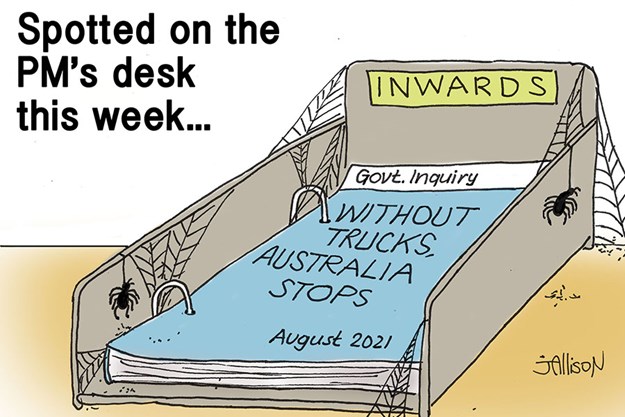OPINION: The more fuel costs rise, the more rates stay the same, to the detriment of owner-drivers
Diesel prices have always been one of the biggest costs and concerns of anyone running a transport business. As I look at the price at our local truck stop now. Prior to the temporary excise cut, it was being sold for the unimaginable price of 229.9 cents per litre. Fuel could hit 1,000 cents/litre and it should not matter. But it does. Why shouldn’t it? And why does it?
It should not, as we should be, compensated for the work we do considering the costs we encounter to do said job. I remember talking to one of my mentors as I was making my way into the industry. He said to me it did not matter how expensive it gets as long as the rate went up accordingly. Well, in my time as an owner-driver, fuel varied 100 cents per litre and the rate never changed.
How is it fuel can double in price over, say, a five-year period, yet rates are not changing to compensate transport company costs? And what does a cent here and a cent there matter anyway?
Let me explain why a cent matters. Let us say an owner-driver uses a single tailer running the Hume and does 220,000km per year. Let us say they get 2.2 km/L. Over 220,000km they will purchase and burn 100,000 litres. Every time one cent is added at the bowser, this equates to 100,000 cents, or more commonly phrased as $1,000. That’s right, every time fuel goes up a cent your bottom line goes down by $1,000/year.
We have just seen fuel jump 60-70 cents. Are you being paid an extra $60,000 to $70,000 a year now? If you carry 250 loads a year that’s $240 to $280 per load. Double that if you are doing longer distances or fewer loads. If your customers are not paying this, then you are going backwards.
I do not know any operator that can give away that sort of money and not lose everything.
Where is the National Heavy Vehicle Regulator (NHVR) in all this? They are not regulating the national heavy vehicle industry. They are responsible for all sections of the supply chain, conducting the business of road transport in a safe way.
Remuneration is the highest peak of safety as it determines the very foundation of being able to operate a safe transport business. I have directly asked NHVR ‘chiefs’ and they say they cannot get involved. That is a lie from an organisation that simply does not want to do the hard yards.
Where is the government in this? Labor Senator Glenn Sterle, who organised the Senate Inquiry into Road Transport, invited the assistant minister for road safety and freight transport, Scott Buchholz, to attend. Minister Buchholz was not interested. Then, when handed the findings on a silver platter, he snubbed it. That’s right, he could not care less about our industry or the wonderful people that make it up. Remember that when you vote!
At the Senate Inquiry I gave evidence and in that I put forward a system that would work to cover fluctuating costs in running a transport business. The following is the guts of it.
Senate submission
By recognising that different areas of Australia are more expensive to operate in I think we can make a great framework that uses geographical areas, as well as different forms of work, to create a standard minimum that must be charged, no matter if the operator is a sole trader, small fleet or 1,000-truck multinational publicly-listed company.
Let us start off with the Hume Highway, Australia’s main street. This freight corridor would be the ‘baseline’ and therefore a single tautliner would attract a designation of one ‘transport unit’ per kilometre.
As areas and jobs become more expensive to operate in and carry out, the ‘transport unit’ would increase.
On this route based on the mean fuel cost being $1/litre, a single tautliner/van dry freight would be one ‘transport unit’ and would be paid say $2/km. Then we add the fuel levy based on real world ‘mean fuel price’. This is easily obtained and would be reported on the ‘contract of carriage’.
RELATED ARTICLE: Maintaining momentum through difficult year
For every cent that fuel goes over $1/litre, 0.5 cents per km must be added (based on 2km/L. We need 0.5 litres every km). In today’s world at $2.30/litre the price would equate to $2.65/km per transport unit (for this geographical area) for today’s fuel price. These figures are an example only.
A refrigerated outfit, or a B-double, etc. would have a higher ‘transport unit’ and therefore a higher rate.
To counteract cost variations in different geographical or industry areas, there would be an appropriate ‘transport unit’ rating.
This system firstly acknowledges the fact that the fuel price will make or break a transport business. Second, this needs to be recognised by everyone in the chain (you know, the Chain of Responsibility), not just the operator struggling to pay the ever-increasing fuel bill on ever diminishing surplus revenue. Everyone should pay their share.
Close interaction with actual transport operators, not pencil pilots of big business, must be consulted when setting the appropriate rates. I am just offering the framework.
At times like this I encourage all operators to know the costs, recognise the point that you are not viable and take immediate calculated action.
Speak to your customers. A good customer will want you to thrive. A customer that does not care for your wellbeing is not worth talking to. Let someone else go broke carrying their freight.
Thanks for reading my first column. Please be safe out there and get home to the ones you love in good health.
|
|
*GORDO MACKINLAY is a former president and current board member of the National Road Freighters Association




.jpg)